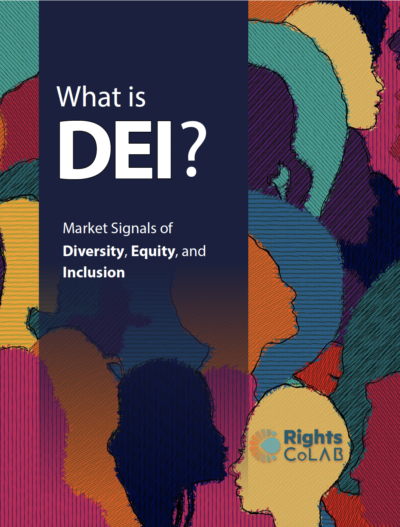“DEI is about creating a culture in an organization that looks like the society in which it is situated – one that values diversity in all its forms, visible and not visible, and sees it as a value creator.” – Paula Luff
Investor interest in Diversity, Equity, and Inclusion (DEI) is strong and growing. But does DEI mean the same thing to investors – and to companies – and do they share the same DEI goals? To have a better window on how market actors are defining Diversity, Equity, and Inclusion, in 2022 Rights CoLab mapped and analyzed 429 metrics used by 21 influential DEI organizations, and captured the findings in the report, What Is DEI? Market Signals of Diversity, Equity, and Inclusion. The report identifies areas of market consensus, divergence, and potential gaps in the metrics, which may lead management to overlook DEI actions and marginalized groups that need attention in order to realize their DEI commitments. Divergences on the scope and emphasis of DEI initiatives means that companies must cope with a patchwork of measurement tools. This complicates both the implementation and monitoring of DEI initiatives.
We developed the report to support the Sustainability Accountability Standards Board (SASB) in its revision of the SASB DEI industry standards, as part of our knowledge partnership with the Value Reporting Foundation. The goal of the Report is to serve as a conversation starter on DEI goals.
One group we are keen to hear from are investors, particularly those who center DEI in their company engagements. So, we asked Paula Luff, Director of ESG Research and Engagement at DSC Meridian Capital, what DEI means to the firm and why it matters to her firm’s investment strategy. DSC Meridian Capital is an “opportunistic” hedge fund that frequently and actively engages with companies about sustainability topics, including DEI, “to help shape positive ESG outcomes.”
This interview was conducted by Joanne Bauer and Manuela Corredor Vasquez.
__________________________________________________________________________
Rights CoLab: Thanks for taking the time to speak with us, Paula, about why DEI matters and what about DEI matters. Please start by telling us about how DEI is relevant to DSC Meridian’s investment strategy – particularly as a “value investor” that integrates material ESG factors into your investment analysis.
Paula: I’m happy to speak with you. The most common ESG risk we see cited by companies in their disclosures is human capital. Recruiting, motivating, and retaining top talent is a priority for management teams—especially in a tight labor market. And strong human capital management is financially material. Intuitively this makes a lot of sense — diversity brings a wide range of perspectives and experience to the decision-making table. Engagement with management teams around DEI opens a window into corporate culture and the quality of strategy execution.
Rights CoLab: What do you think are the most decision-useful DEI metrics?
Paula: Asking companies to identify their goals and to describe their DEI strategy to achieve it leads to better insight into the quantitative data they provide and the competitive advantage or disadvantage the company offers. Also, pay equity disclosures can be revelatory.
Rights CoLab: There’s a general perception in the market that investors need quantitative data and that the difficulty of capturing social issues by a numerical metric is one of the reasons the “S” in ESG is so confounding.
Paula: It’s true that investors rely on quantitative data – it is needed to build the mathematical models used in decision making. Quantitative data is the foundation of investment underwriting. However, there is significant qualitative data that goes into the financial analysis because investors need the qualitative context to be able to interpret the numbers.
Rights CoLab: That’s true. As with any sustainability topic, DEI disclosure can easily turn into a tick-box exercise that doesn’t meet the need…
Paula: There is too much focus on what we can count. The challenge with DEI is that it is easy to tick representation boxes—say 30% female representation, or 40% underrepresented minorities. We have to get beyond numbers. DEI is not so much about how many people you have that identify with a specific group, but more about how DEI informs the corporate strategy, how it creates value, and how it strengthens the organization. Getting at that data requires speaking with the company, but not all investors are able to take that approach.
Rights CoLab: What are the main stumbling blocks companies face in advancing their DEI goals and objectives?
Paula: One stumbling block is coming up with a standard set of metrics applicable to global enterprises. DEI is specific to different locations and cultures – DEI in the U.S. is different from DEI in Europe and in other geographies.
In every context there are qualitative nuances of corporate culture that quantitative data don’t necessarily tell you about. For example, a company can tell you that its board and leadership are diverse because half of its members are women or disclose that a certain percentage of its promotion rates met diversity standards. But that information by itself does not tell you about the qualifications of the diverse and inclusive representation. I need to understand what the criteria was for making those promotions, what is the retention impact, what is the business impact. Another common metric companies report on is the number of DEI trainings they deliver to their employees. But this figure does not tell us much about the quality of those trainings – in other words, what are the training outcomes that can effectively lead to changes in management behaviors? To change the culture in organizations we need to focus more on the outcomes the training can produce.
Rights CoLab: Changing corporate culture is a big lift, though…
Paula: As Peter Drucker said, “culture eats strategy for breakfast.” Actually, culture matters now, more than ever. Younger people base their employment decisions on the culture, values, and purpose of the corporation. And today there is really fierce competition for top talent, so it is no longer enough to pay people well and provide four weeks of vacation. Companies need to move the extra-mile and create a valuable experience where employees feel they belong and are valued. That is hard to put in numbers.
Rights CoLab: Do you think DEI disclosure metrics should be constructed so as to allow companies to create their own targets? Or is it better for metrics to be specific, particularly when it comes to recognizing marginalized groups? The risk of not specifying is that some groups will be overlooked.
Paula: Numbers without targets or a sense of where they are heading and why, are meaningless. So, companies need to set their own targets, but they need to explain them and what the ultimate objective is. Again, the definition of under-representation will vary by country and industry, so I am not sure that a single set of metrics will be useful for a company operating globally. We need to ask companies how diversity within their workforce compares to that of peer companies and the broader environment in which they operate.
Rights CoLab: In conducting research for our DEI mapping report, we shared our preliminary findings with over 30 stakeholders in the Global North and Global South who are working in the DEI space to get their feedback, which we then integrated into the report. One topic that surfaced during these conversations is the failure to account for unconscious bias in hiring strategies. The metrics do not explicitly point companies to consider how unconscious bias may hamper their efforts. Do you ask companies questions about who their hiring committee is or how they structure their hiring processes?
Paula: Again, stakeholders – investors included –need to ask deep questions around the hiring process. You will get at that not by asking how do you avoid unconscious bias, but by being more specific: How do you review resumes? Are names and gender identifiers redacted for the reviewers? What about the names of educational institutions? Are pay levels for each position tied to skills and experience? What other factors determine pay?
Rights CoLab: What about DEI and supply chains, two areas that are often treated separately. Our DEI Report shows that DEI goals as defined by the metrics are mainly concerned with an enterprise’s direct workforce, and rarely with workers in their supply chains – though we do see metrics about communities where the enterprise operates. In the report, we argue that in order “to apply metrics to supply chains, individual companies will need to tailor them to unique social and cultural situations of different communities in which they operate.” Do you agree?
Paula: I agree with that. But companies have a lot more influence over their direct suppliers than further down the chain. We should help companies coalesce around the global expectation of what good looks like and strive to advance worker rights where they can influence. To address issues further down in their supply chain, companies should provide tools to their direct suppliers that they can use to work with their direct suppliers.
Rights CoLab: We found that DEI frameworks do not address migrants and refugees. In a Fireside Chat that IDiF hosted in October 2022, racial equity investing expert Sharlene Brown said that as the U.S. has become a majority-minority country, we in the U.S. have a big opportunity to become the model on how to bring a solution to the fundamental problem of discrimination. Of course, if we think about risks in the supply chain, the focus needs to be on migrants and refugees, who are the most vulnerable to exploitation and discrimination in nearly all societies.
Paula: Absolutely. There is a little bit more focus on the direct workforce. In terms of vulnerable populations, both in the direct workforce and supply chains, it is correct that there is not a lot of consideration for migrants. That is a huge oversight. The challenge is how to keep something that is as broad and varied as DEI to harness metrics and make companies more competitive with more resilient, diverse, and inclusive workforces.
Rights CoLab: Let’s get back to management. More than half of the 21 DEI frameworks we look at lack metrics on management accountability for their DEI targets, goals, and strategies. How do you assess DEI management within a company?
Paula: One of the things we look for is alignment of executive compensation with ESG priorities. So, if a company says that their DEI mission is a priority to them, that needs to be reflected in the annual bonus and the long-term incentive plan of the executives. There need to be meaningful targets that tie back to strategy and the percentage of compensation tied to achieving the targets cannot be trivial in order to hold executives accountable for the outcomes.
Rights CoLab: Final question: What would you tell other investors about how to determine whether a DEI strategy is effective? And how are companies evolving in their DEI strategies and in embedding them into their operations?
Paula: Not every DEI category is material in every context. DEI needs to be tailored to the company and to its circumstances – in other words, its industry or geography. Some factors are more financially material than others. That is why SASB is so relevant – because it focuses on what is material for a particular industry. But irrespective of industry, there is a core set of human capital metrics or issues that are material to every employee, and the challenge is landing on what those metrics really are.
When we review company disclosures, we want to understand the drivers behind the data. The only way to understand the context is to speak with management and ask probing questions to get at the context – to understand how the company views DEI in the context of growth and resilience. Those are the type of questions investors and stakeholders should be asking companies – not just what your numbers are, but what is driving this.
Companies have started to get this. But it takes time for them to pivot. There are industries where diversity and equity can take even longer due to the lack of diverse talent in segments of the workforce. Companies can start making the shift by promoting educational programs and internships with diverse cohorts, and by promoting real mentorship and sponsorship programs with vulnerable groups.
Photo by Alexander Grey on Unsplash




